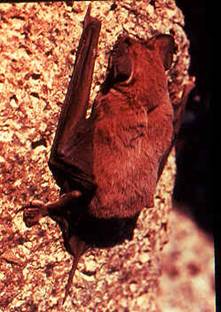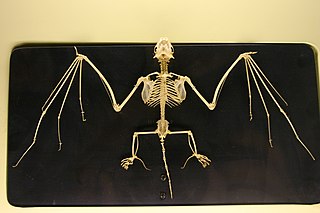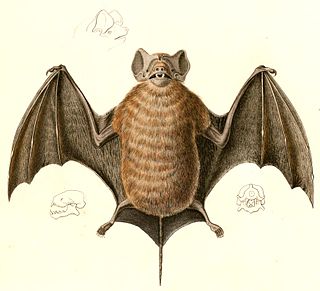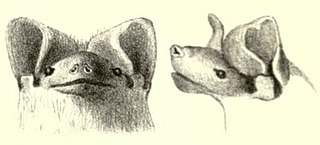
The Molossidae, or free-tailed bats, are a family of bats within the order Chiroptera. The Molossidae comprise the fourth-largest family of bats, containing about 110 species as of 2012. They are generally quite robust, and consist of many strong-flying forms with relatively long and narrow wings. Another common name for some members of this group, and indeed a few species from other families, is mastiff bat. The western mastiff bat, a large species from the southwestern United States and Mexico with wings over 0.5 m (1.6 ft) across, is perhaps one of the best known with this name. They are widespread, being found on every continent except Antarctica.

Molossus is a genus of bats. The genus contains ten species with a New World distribution from Mexico in the north to northern Argentina at its most southerly limit. Four of these species have distributions that include various islands in the West Indies such as Puerto Rico or Trinidad.

The Molossus or Molossian hound is a extinct breed of dog from ancient southern Europe.

Molosser is a category of solidly built, large dog breeds that all descend from the same common ancestor. The name derives from Molossia, an area of ancient Epirus, where the large shepherd dog was known as a Molossus.

Crotalus molossus is a venomous pit viper species found in the southwestern United States and Mexico. Four subspecies are currently recognized, including the nominate subspecies described here.
A molossus is a metrical foot used in Greek and Latin poetry. It consists of three long syllables. Examples of Latin words constituting molossi are audiri, cantabant, virtutem.

The Bonda mastiff bat or Thomas's mastiff bat, is a species of mastiff bat from South and Central America. It is named for the town of Bonda, near Santa Marta in Colombia.

The velvety free-tailed bat or Pallas's mastiff bat, is a bat species in the family Molossidae.

The black mastiff bat is a bat species. It ranges from the northern region of South America, most of Central America and parts of southern Mexico.

Glyphoglossus molossus is a species of frog in the family Microhylidae. It is monotypic within the genus Glyphoglossus. Its common names are Blunt-headed Burrowing Frog and Balloon Frog, among others.

The northern free-tailed bat is a species of bat in the family Molossidae. It is found in Indonesia and Malaysia.

Miller's mastiff bat is a species of bat in the family Molossidae. It is found in Brazil, Colombia, Costa Rica, Guyana, Mexico, Nicaragua, and Venezuela.

The Sinaloan mastiff bat is a species of bat in the family Molossidae, native to Mexico, Central America and northern South America.

The Aztec mastiff bat is a species of bat in the family Molossidae. It is found from Jalisco and Cozumel Island in southern Mexico to Nicaragua in a variety of forest habitats at elevations from near sea level to 1300 m. It has also been reported from southern Venezuela. The species' diet is insectivorous.

The Coiban mastiff bat is a species of bat in the family Molossidae. Its range extends from Chiapas in southern Mexico to Mato Grosso in Brazil, including Peru, Ecuador, Venezuela, Panama, Costa Rica and El Salvador. The taxonomic status of the populations in Central America is uncertain. The species is insectivorous and is known from a variety of forest habitats at elevations from near sea level to 1300 m.
Crossotini is a tribe of longhorn beetles of the Lamiinae subfamily. It was described by Thomson in 1864.

Molossus of Epirus is an ancient livestock guardian dog breed from Greece and Albania. The breed has been bred since the age of Alexander the Great to protecting livestock from carnivorous mammals including the wolf, European jackal and the brown bear in the mountainous regions of Greece and Albania, especially in Epirus. The Molossus is a pure Greek breed and is believed to be one of the main ancestors of today's Molosser breeds, such as the English Mastiff and the Neapolitan Mastiff,
Epidichostates strandi is a species of beetle in the family Cerambycidae. It was described by Breuning in 1935. It is known from Benin, the Ivory Coast, Gabon, Ghana, Cameroon, Guinea, the Democratic Republic of the Congo, and Sierra Leone.















